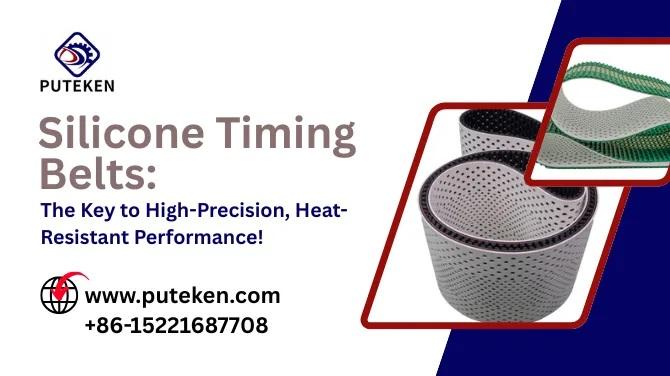Notifications

8 minutes, 23 seconds
-44 Views 0 Comments 0 Likes 0 Reviews

In the vast world of machinery and automation, timing is everything—literally. From the smooth function of your office printer to the high-speed precision of pharmaceutical packaging lines, timing belts play a crucial role in synchronizing motion. Among the many variants available, one belt quietly outshines the rest in performance and adaptability: the Silicone Timing Belt.
At first glance, it may seem like just another component. However, once we dive into its unique properties—ranging from high heat resistance to ultra-clean surface finishes—it becomes clear why industries worldwide are turning to silicone as their material of choice. Whether you're a production manager looking to upgrade your machinery or an engineer designing high-speed applications, understanding the power of silicone timing belts can revolutionize your workflow.
A Silicone Timing Belt is a specialized belt designed for synchronous drive systems, constructed primarily from high-grade silicone rubber. Unlike traditional rubber or PU belts, silicone belts offer a wider range of performance benefits, making them ideal for demanding environments where temperature, hygiene, and noise are concerns.
How It's Made?
Silicone timing belts consist of:
The result is a belt that’s not only flexible and strong but also highly resistant to external contaminants and extreme temperatures.
Advantages of Silicone Timing Belts
High Temperature Resistance
Silicone belts can withstand temperatures ranging from -60°C to 200°C, making them ideal for:
Non-Stick and Chemical Resistance
Unlike standard belts, silicone belts resist:
This non-stick surface makes them perfect for:
Noise Reduction and Smooth Operation
Say goodbye to the clunking of outdated belts. Silicone timing belts run with a whisper-like hum, reducing:
Long-Lasting Durability
Thanks to its resistance to fatigue and abrasion, silicone belts offer:
Hygienic and Easy to Clean
Silicone's non-porous surface ensures that:
Industrial Applications of Silicone Timing Belts
Food and Beverage Industry
In bakeries, confectionery, and ready-meal production lines, belts need to:
Silicone belts check all the boxes. They're food-safe, non-stick, and easily washable.
Medical and Pharmaceutical Manufacturing
Whether it's capsule filling or sterile packaging, silicone belts provide:
Electronics and Cleanroom Environments
Silicone belts are used in:
Why? They’re low-friction, anti-static, and generate almost no particulate matter.
Textiles and Printing Machines
Printing presses and textile rollers need belts that:
Silicone belts deliver consistent print alignment and zero slippage.
How Silicone Timing Belts Improve Operational Efficiency?
Reduced Downtime
Fewer maintenance cycles mean:
Enhanced Accuracy and Synchronization
For robotics and high-precision applications, timing is vital. Silicone belts ensure:
Shanghai Puteken Transmission System Co., Ltd.: Industry Leader in Silicone Belts
Custom-Built Belt Solutions
Shanghai Puteken specializes in:
Focus on Quality and Innovation
Every belt is:
Comparing Silicone Timing Belts to Other Materials
Silicone vs. Polyurethane (PU)
PU belts are good for durability, but:
Installation and Maintenance Tips
Proper Tensioning and Alignment
To avoid premature wear:
Cleaning Techniques
Use:
Avoid strong acids or high-pressure water jets.
Sustainability and Environmental Impact
Silicone belts offer a greener solution through:
Common Myths About Silicone Timing Belts
"They’re too expensive."
The initial cost is higher, but the ROI is better due to longevity and fewer maintenance stops.
"They’re fragile."
On the contrary, silicone is highly resistant to cracking, tearing, and deformation.
"They can’t be customized."
Not true—Shanghai Puteken offers full customization options.
The Future of Silicone Belting Technology
Imagine belts that:
Shanghai Puteken is already exploring these frontiers.
From food factories to cleanrooms, the Silicone Timing Belt is revolutionizing motion systems. Its unique blend of high temperature resistance, hygienic properties, and whisper-quiet operation make it an essential upgrade for any high-efficiency production environment.
So, if you're aiming to improve your industrial workflow without compromise, it’s time to embrace the smart choice—Silicone Timing Belts from Shanghai Puteken Transmission System Co., Ltd.
1. What is the maximum temperature a silicone timing belt can withstand?
Up to 200°C depending on the specific belt configuration.
2. Is silicone safe for food-grade applications?
Yes, it’s FDA-compliant and ideal for direct contact with food.
3. How does silicone compare with traditional timing belts in terms of longevity?
Silicone belts often last 2–3 times longer due to their durability and resistance to wear.
4. Can silicone timing belts be customized for different machines?
Absolutely. Shanghai Puteken provides full customization for length, width, and tooth profile.
5. Where can I get high-quality silicone timing belts?
Visit Shanghai Puteken Transmission System Co., Ltd. or reach out directly for a tailored quote.

